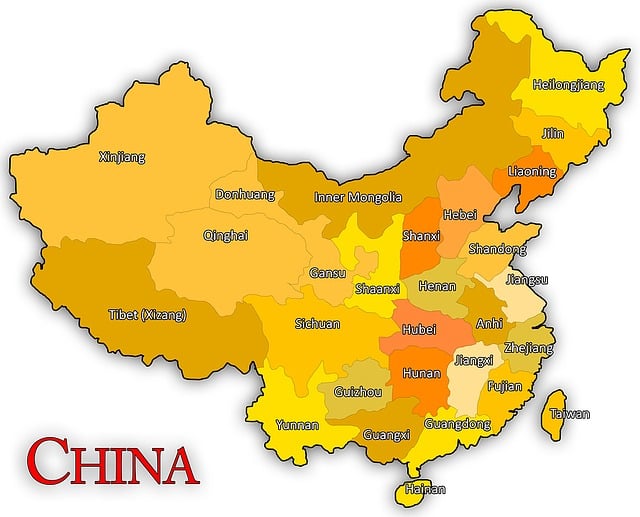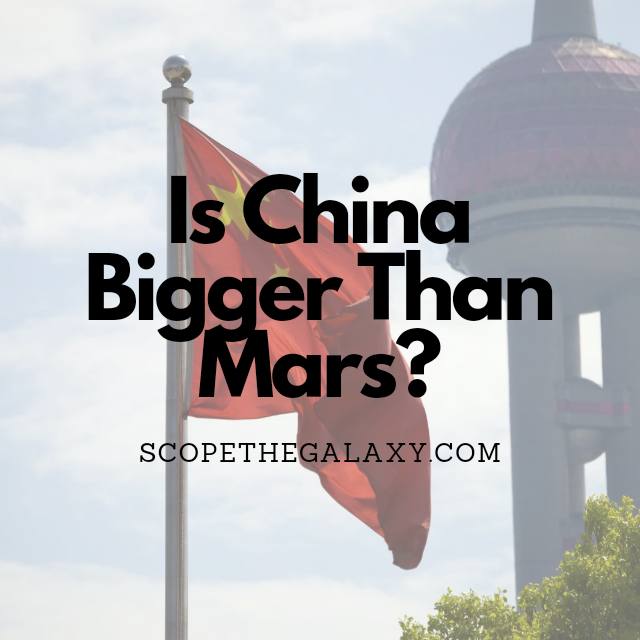*This post may contain affiliate links. This means we may make a commission if you purchase an item using one of our links*
China is the third largest country on Earth, while Mars is the second smallest planet in our solar system. As a result it only makes sense that it’d be bigger with a surface area of 144.8 million sq. km compared to China’s 9.7 million sq. km whereas China’s volume is far smaller at 462 million cubic km compared to Mars’ astronomically larger 163 billion cubic km.
For a more thorough breakdown of what makes China and Mars as big as they are, continue reading as it will be covered below.
How Big Is China?

China – officially named the People’s Republic of China – is the third largest country in the world and is located in East Asia. It is also the most populous country in the world, with a population of over 1.4 billion people.
China has a land area of 9,388,211 sq. km and a total area of 9,706,961 sq. km. The total area comprises not only the land mass but also the bodies of water (such as lakes and rivers). China has a diameter of 5,000 km stretching from east to west and a north-south length of 5,500 km.
One-third of China’s total land area comprises mountains, and it is home to the tallest peak in the world, Everest, which occupies the border between China and Nepal. Thanks to this mountainous terrain, the average thickness of China’s continental crust is 47.6 km (the average global thickness is 39.2km). This gives China an estimated volume of 462,051,344 cubic km.
The topography of China is varied and encompasses the highest and one of the lowest places on Earth, with climates that vary from dry desert to tropical monsoon. In fact, China has the greatest north-south temperature contrast of any country in the world.
China’s coastline runs for around 14,000km, while its land frontier extends to 20,000km to encompass its borders with 14 other countries, including Russia, Mongolia, India, and Kazakhstan. Generally speaking, China has a high west side and a low east side, meaning that many of its rivers flow eastward.
The vast expanse of this country covers almost five time zones, but China operates under a single time zone to unify the country.
How Big Is Mars?

Mars is the fourth planet in line from the Sun and the second smallest planet in our solar system. It has a diameter of 6,779 km, which is only just over half as large as Earth’s (around 53%)
The physical geography of Mars is very different from that of Earth. The atmosphere on Mars is much thinner than ours, and it consists mainly of carbon dioxide (CO2) with small amounts of nitrogen (N2). The surface gravity on Mars is much lower than that on Earth, so an object that weighs 100 pounds on Earth, would weigh just 38 pounds on the red planet.
The surface of Mars is mainly composed of various minerals like iron oxide and silicon dioxide. It also has polar ice caps, but it doesn’t have any oceans or seas.
Olympus Mons is the largest volcano on Mars, with a diameter of 600km. And it is the largest mountain in our solar system, standing at roughly 27km high (almost three times the height of Mount Everest)
The Valles Marineris system of valleys is a vast network of canyons on Mars; the largest canyon in the solar system. It is located in the planet’s southern hemisphere and extends for around 4000 kilometers from east to west; the deepest points can extend up to 10km.
The basic makeup of Earth and Mars is similar as they are both terrestrial planets with a dense metallic core and overlying crust and mantle. However, Earth’s density (5.514g per cubic cm) is higher than Mars’ density (3.93g per cubic cm), suggesting that the red planet’s core contains lighter elements than Earth’s.
The surface area of Mars is around 144.8 million sq. km, about 15 times the surface area of the China. Meanwhile, the volume of Mars is approximately 163 billion cubic kilometers, roughly 350 times that of China.
Summary
There isn’t a single measurement in which China outclasses Mars, whether it be diameter, surface area and most definitely volume.
China may be amongst the biggest countries on the blue sphere we call home and may even outsize the smaller moons scattered within our solar system but, it simply cannot match the size of a planet, especially one the size of Mars, due to their spherical shape.

